Perhaps instead of “old linens,” I should use the term “vintage,” which has a much better ring to it! What about working your own hand embroidery on vintage linens? Do you think it’s a good idea, or would it be a waste of time, since they’re already… um… “old”?
I was considering the question of doing some hand embroidery – specifically, whitework – on vintage linens because I had the opportunity to acquire a couple vintage pieces that I liked.
One piece is a table runner or dresser scarf with a hand-crocheted edge all around it, and a very elaborate crocheted design with tassels on each end.
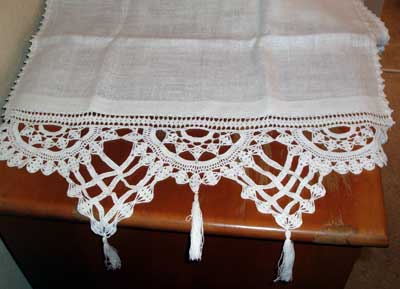
The crocheted edge needs to be pressed and re-situated, but you can see that it’s a rather complex edging which could propose a problem for the embroiderer: I wouldn’t want to mar the crochet with a hoop or snag it or anything like that! So that could be an “in-hand” job, if necessary.
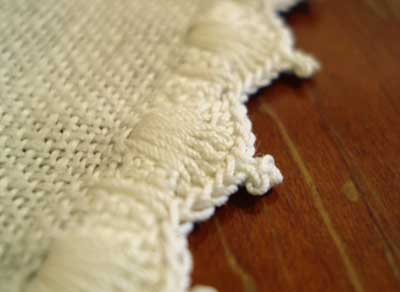
The edging all around the linen is very pretty, and a bit simpler. I love the picot at the tip of each scallop.
The other is a buffet cloth – long and narrow, scalloped on three sides, with a straight edge that would run along the back of a buffet. The scallops are finished in an overcast stitch, and then a crocheted edge is added for a nice finish.
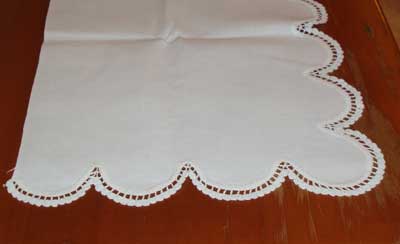
The linen on the piece is exceptional – a smooth hand, and a crisp finish. It’s so nice! It’s not slubby at all. It reminds me of Legacy’s Ecclesiastical Linen – a perfect weight for whitework.
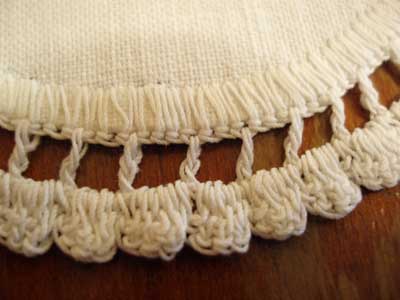
The edge is nicely done. The only flaw in the piece is a tiny whole at one point on the linen. I was thinking that, if I did do some whitework on this piece, I could use a pattern with eyelets and get rid of the hole by turning it into one!
These were offered as vintage linens from a reputable seller, and you can tell they aren’t new, but I don’t know enough about vintage textiles to approximate when they were made – they’re not that old, anyway. The sheen of both is nice, but the second piece is certainly finer linen. It’s a brighter white, while the first piece is slightly ecru and the linen itself is more coarse.
So, that is what I am contemplating – should I or should I not add further embellishment with some whitework on either linen? What do you think? Have you undertaken such a project before? Any tips?



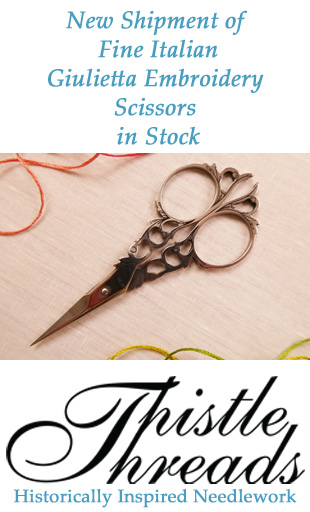
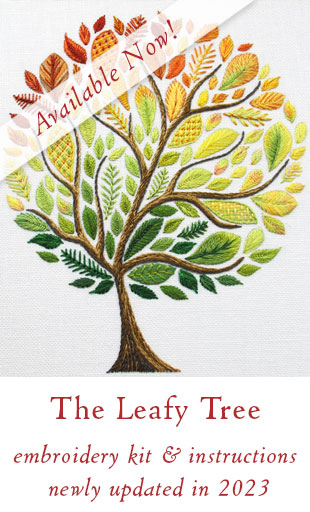
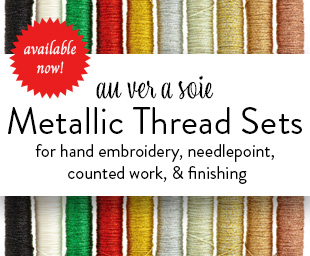

I, too, have some vintage linens that I plan on embroidering some day. I bought a set of old napkins many years ago and embroidered a motif from my china on them. The only concern that I have about embellishing a vintage piece is if I do something that can’t be undone (such as cutwork or drawn thread work) because I can’t just go buy another piece of linen. Other than that what reasons would there be for *not* embroidering on vintage linen? I also think it’s important to respect the piece and not put something on it that might be inappropriate design-wise, but that’s a matter of individual taste.
Also, with regard to hoop marks on the edging perhaps you could use a very small hoop and/or an oval. I guess it depends upon how close to the edge you wish to stitch. You might also be able to attach the linen to another piece of fabric and mount that in a slate frame.
I was once told in a cutwork class that old linen fabric is potentially better quality than any fabric we can buy today. If I remember correctly it had something to do with the flax plants of the past producing better quality source material for the linen. The flax plants of today don’t (or can’t) produce the high quality flax of the past. I remember being really sad to learn this.
No tips to offer, Mary, but I do think you should let yourself undertake this…it sounds like the second piece has the nicest linen…and what a pleasure that would be to stitch through!
My Rust Red Iris in Long and Short stitch was done on an old piece of linen.
I think it’s a good idea – bringing new life to pieces of lovely material and decorated edging that would otherwise probably just sit in a linen cupboard somewhere.
My experience embroidering on old linens has been positive. I’ve found I can embroider over holes if they can fit into the design and aren’t too large. Also, some of the handworked pieces passed along in my family are damaged but the trim work – crochet, etc. – can be salvaged and reused.
Mary, please don’t use old linen as sewing surface. I collect old pieces in fairs & on Ebay and I display them publicly with as much information as I know, describing the piece and the work done and approx. circa. I know it is tempting but please resist for the sake of history. Only in houses is it okay to say, “and this wing was added 50 years later”!
I realize that this comment is almost a year-and-a-half late, but I have to admit (having indulged in a recent orgy of discovering your website!), that I have embroidered on vintage linens myself.
I think it's important to distinguish between historical vintage items and items that have aged and developed problems in the process.
I have a number of family pieces that I would not dream of changing as I know their histories and care about preserving exemplary pieces of artwork.
I have also come to acquire pieces of unknown heritage that had stains that did not succumb to cleansing (or had out-and-out holes, like yours). In these cases, I have had absolutely no compunction about "darning" the problem areas in a decorative fashion.
I strongly believe that surface embellishment followed methods of repair in the history of needlework. In our modern era, we tend to think of embellishment first, and repair as a final, desperate measure. This, in my eyes, is merely a sign of how disposable objects have become in the modern world.
Once, however, fabrics were both scarce and precious. They required tremendous labor from production of the original fiber, to spun thread, to woven fabric to….
Making eyelets over holes, then balancing them within a design makes perfect sense to me in an earlier age, when nothing was disposable. Over time, skilled needleworkers may have conveyed their "cunning" to people with more wealth, and the "art" of needlework was born. But, today, if you want to take a piece that would otherwise be viewed as "imperfect" and make it beautiful and useful, I see that as a historically valid "repair" — and I think the maker would have approved!
Any idea what the pattern name is for the elaborate crochet edging above, or about how old the piece might be? I have similar piece.
My name is claire and i love your vintage edging pattern! i found the pattern about 7 years ago although i cant remember where! i would love to be able to get this pattern if there is any way you can help me? your discription of the pattern as written on your web site is: One piece is a table runner or dresser scarf with a hand-crocheted edge all around it, and a very elaborate crocheted design with tassels on each end. and there is also a picture of the pattern (all white in color) thank you very much.
i would never presume to embroider on a vintage piece. that is a piece of history and it should be respected. the pieces you have shown are all about the simplicity of the linen, counterpointed by the exquisite edging. There is nothing worse than a person deciding they can make a piece of the past better. I found an incredible pillow cover from the 1910’s that had Bara Fem Minuter embroidered on it. i bought it and my friend who was a dealer said “oh i saw that and was going to rip that out of the design because he didn’t “like’ it”. well it took me a few years to figure out the language, and it was Danish for “just five minutes” to take a little nap. how sad it would have been if my friend had destroyed that because he thought it would sell better without the words he didn’t understand. this is very common in the antique world. Respect the past, it is our job to preserve it.
I think you should give ita go – both pieces have plenty of scope for small amounts of further embellishment. The runner with the tassels could have a small amount of stitching along the long sides – holding it in a hoop or rectangular frame would not be too difficult – the tassels should be easy enough to undo then reform once the work is complete, and the crochet could be protected with tissue or muslin. A rectangular frame would suit the purpose best, I’d say. Remove the work from the frame when the work is finished per session – I’m sure you do that, anyway!
The scalloped piece has plenty of scope and needs only an imagination and that seems to be in good supply with you!
Good luck with your endeavours.
I have inherited my Mother’s collection of Antique Linens and it is very extensive. And since I am not in this as a business I would love to find a way to use some of these to get back into needle work. Now I will have to prepare them to use for needle work.I would only do this on some that have holes or if the lace is beginning to come apart.Thank you for the idea.From the owner of thousands of pieces of vintage linens.
Hi!
I was given several old pillowcase tubes, dresser scarves, bridge sets, small tablecloths. They haven’t been finished. Some have the instructions with them but many don’t. I was wondering if you had any idea as to where I could look for the instructions? I know it’s a long shot but any suggestions would be helpful. It would be nice to finish these pieces the way the were meant to be!
Thank you
Janet Adams
Hi, Janet – for pre-printed or stamped pillowcases and the like that are older, you probably won’t find the instructions available – unless you happen to know the manufacturer’s name and the name of the kit or design, in which case you could google it and see if anything comes up. Your best bet is probably just to finish them in a way that makes sense, that blends with the previous embroidery. It doesn’t have to be exact, but I bet you could get it close by just studying the stitches that were used and doing the same ones.
I have a huge simple linen tablecloth along with napkins (some a vivid pink) given to me by my aunt, who entertained extensively as the wife of a USAF general way back in the day. The tablecloth is thinning in some places, has some stains from hard use. I can see how linens such as the ones you have may or may not have provenance, but for me, I think the best use of all for pieces such as those I have is reuse. Thoughtful reuse, but reuse. NO ONE in my family will EVER use these as they were designed. I don’t think they would be saleable due to their condition, and besides, I’d rather feel warm fuzzies about reuse than someone buying them to line their dog’s bed. (That would be a lucky dog, but still . . . ) I would rather have a tote that I use with a piece of work on it I did, and give one to my sister to use to tote goodies to her grandchildren. Special, special use, warm feelings. And really, no loss to history in this way.